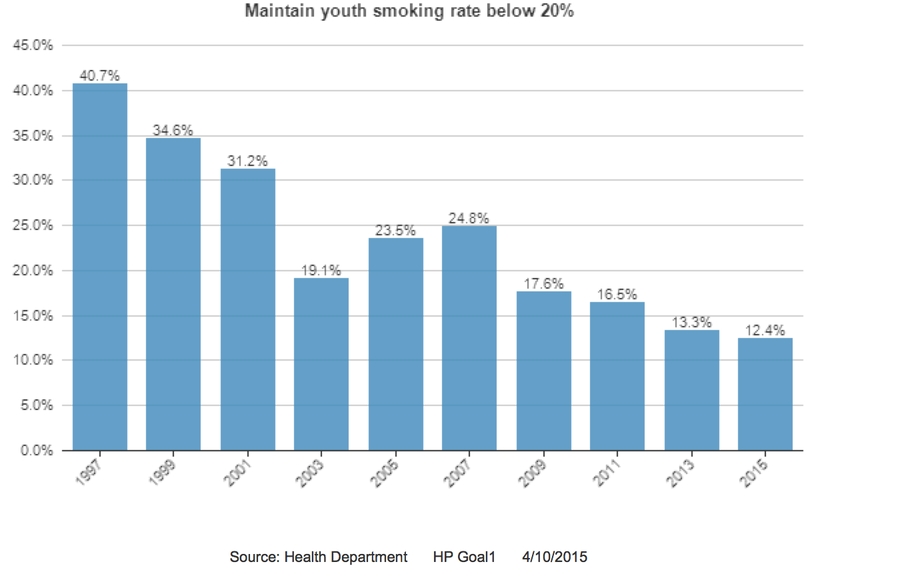Appendix B
Baltimore, MD, has identified Safer Streets, which makes up 33% of Baltimore City’s $2.549 billion operating budget, as a priority outcome, with six key strategies that support the priority outcome. The strategies outline diverse agency actions such as code enforcement, zoning classification, outreach to at-risk youth, etc. Five goals support the priority outcome, and each goal is accompanied by a KPI. The KPIs may not be representative of all activities for which an agency is responsible.
Increase the percentage of citizens that rate the City safe or very safe.
Mayor's Office
Baltimore Citizen Perception of Safety “Very Safe” or “Safe” Responses
66.25%
65%
Reduce violent crime rate.
Baltimore City Police Department
Baltimore's Violent Crime Rate per 100,000 People
1,426
1,406
Reduce property crime rate.
Baltimore City Police Department
Baltimore's Property Crime Rate per 100,000 People
4,717
4,650
Increase the percentage of Fire responses that meet national standards.
Baltimore City Fire Department
Percent Fire Responses that Meet National Response Standards
87.8%
87.8%
90% (national standard)
Percent of Fire and EMS 911 calls meeting national response time standards.
Baltimore City Fire Department
EMS Response Time Meeting Standards
38.5%
40.1%
Source: Section 1: Mayoral Objectives
Richmond, VA, is in the process of aligning its priorities, goals, and metrics. The city has identified 44 KPIs in its seven focus areas to track progress toward the city’s strategic priorities. Richmond tags each KPI to the associated initiative and is in the process of calculating baseline data to accurately determine expected outcomes in the performance-based budgeting process.
Focus Area 1: Unique, Healthy, and Inclusive Neighborhoods & Communities
Poverty Rate To decrease the percentage of population living at or below the poverty line
26.3%
-Increase SNAP Participation Rate -Teen Pregnancy
City Health Ranking To obtain targeted health goals including infant mortality, low birth weight, and obesity.
125/131
-Develop Office of Multicultural Affairs -Resource Centers -Food Policy Task Force -Office on Aging and Persons with Disabilities -Breastfeeding Commission
Neighborhoods and Community Amenities/Assets Index Increase percent of population that has access to key amenities (schools, parks, recreation facilities, retail, etc.)
Under Development
-Riverfront Plan -Swimming Pool Renovations -School Construction -Cannon Creek -Monroe Park Improvements -Southside Community Center -Pedestrian, Bike and Trails Initiative -Virginia Capital Trail -Library Renovations
Cultural Events Increase the number of cultural events in the City
Under Development
-Increase Cultural Events at Libraries
Blighted and Derelict Property Decrease the number of properties with code violations to 500
2140
-Blight Abatement
Mixed Income Housing Availability in RRHA Increase the percent of housing units available for middle and lower income individuals
Under Development
-Eastview Whitcomb Initiative -East End/ Nine Mile Road Transformation -Dove Court Revitalization -Hull Street Corridor Revitalization
Lincoln, NE, developed 132 performance indicators to measure the City's progress toward the 39 goals in the eight outcome areas. On its Taking Charge website, the city displays justification and support for each performance measure and describes the strategy to achieve each goal.
Outcome Area: Healthy & Productive People
Goal 1: Maintain community's health status

About this measure: This measure indicates the rate of self-reported smoking in samples of students in grades 9-12 voluntarily participating in the Youth Risk Behavioral Survey (YRBS). LLCHD conducts the YRBS every other year in Lincoln and Lancaster County high schools; the Nebraska Department of Health and Human Services conducts the YRBS every other year in high schools across the state.
Why this is important: More than 80% of adult smokers began smoking before 18 years of age. Every year 2,000 youth in Nebraska under age 18 become new daily smokers. If current smoking trends continue, 36,000 children and youth now alive in Nebraska will likely die prematurely from smoking related illnesses. Preventing youth from starting to use tobacco is far more effective than helping them break the addictive behavior.
What is being done: Youth continue to experiment with tobacco in succumbing to peer-pressure, tobacco advertising, and emulating negative behavior of adult role models. LLCHD, TFLC, City departments and community partners strive to prevent initiation of tobacco use and reduce current rates of youth tobacco use by:
Monitoring retailer compliance of illegal sales of tobacco products to minors
Educating youth on the dangerous consequences of tobacco use
Educating youth on the impact of tobacco advertising
Assist youth sports organizations in establishing tobacco-free policies
Promote tobacco free environments
Utilizing peer support to prevent tobacco initiation
Source: Lincoln’s Taking Charge Performance Indicators
Last updated